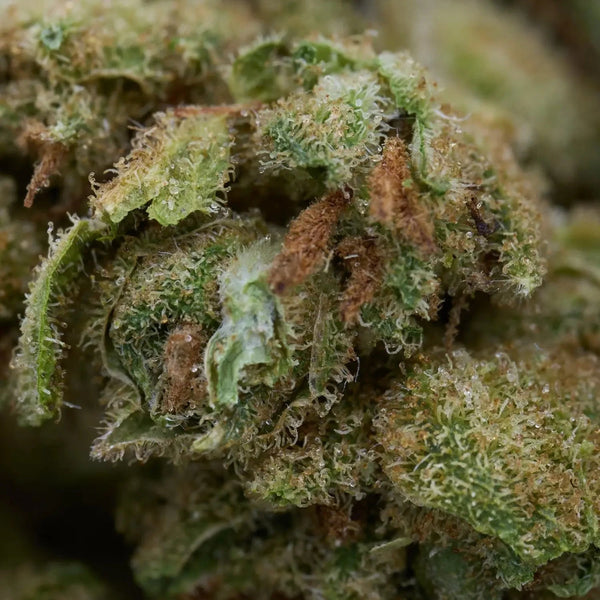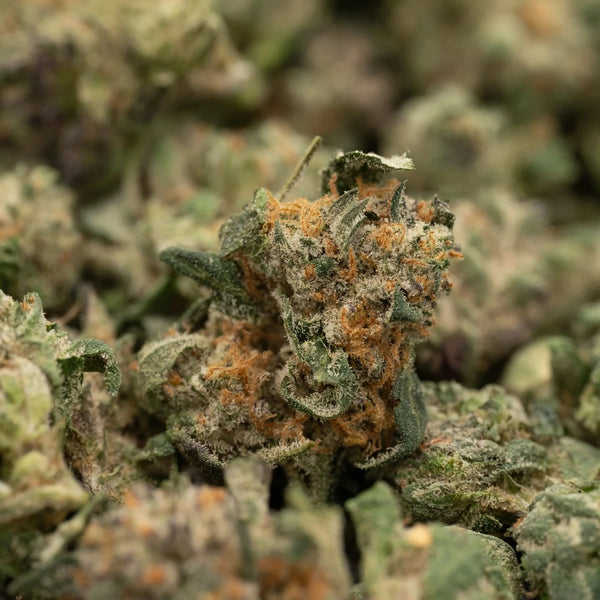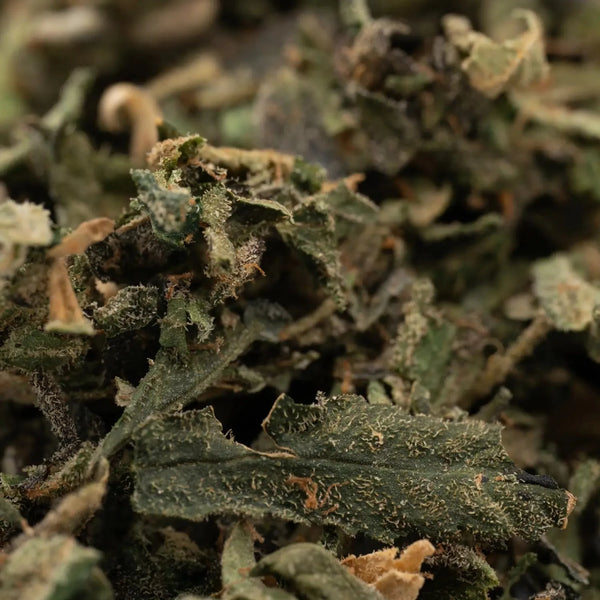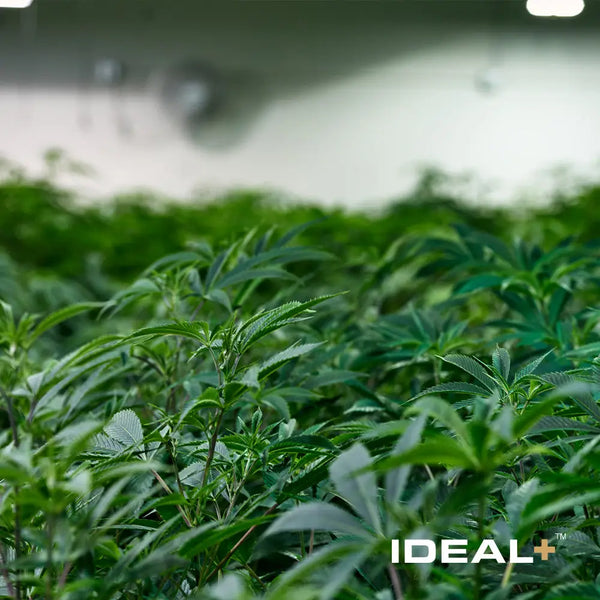No Products in the Cart
Free 2-3 day USPS Priority Shipping With Orders Over $85

For thousands of years, humans cultivated, consumed, and celebrated cannabis without knowing about one of its most abundant compounds. Ancient civilizations in China, India, and the Middle East used cannabis for medicine, ritual, and recreation, completely unaware that the raw plant contained a non-intoxicating precursor molecule that would revolutionize our understanding of cannabis chemistry. This compound—tetrahydrocannabinolic acid, or THCA—existed in every cannabis flower throughout human history, yet remained scientifically invisible until the mid-1960s.
The THCA discovery date marks a pivotal moment in cannabinoid research. While many people wonder when was THCA discovered, the answer reveals a fascinating story of scientific persistence, international collaboration, and breakthrough methodology that occurred during a transformative decade for cannabis research. The history of THCA discovery is intrinsically linked to the broader exploration of cannabis chemistry and the race to understand why this ancient plant produced such profound effects on human physiology.
Understanding how THCA was found requires us to journey back to 1960s Israel, where a young chemist named Raphael Mechoulam would make discoveries that would echo through decades of cannabis science. The story of who discovered THCA is not just about one scientist's curiosity—it's about the convergence of improved laboratory techniques, changing attitudes toward cannabis research, and the persistent human drive to understand nature's chemical mysteries.
Today, as we explore various THCA products and benefit from this compound's unique properties, it's worth reflecting on how recently we discovered what was hiding in plain sight all along.
Before we can appreciate the significance of when THCA was first identified, we must understand the challenging landscape of cannabis research in the early and mid-20th century. The 1960s cannabis research era represented a dramatic shift from the preceding decades, when studying cannabis was fraught with legal, social, and technical obstacles.
Following the passage of the Marihuana Tax Act of 1937 in the United States and similar prohibitive legislation worldwide, cannabis research essentially ground to a halt. Scientists who might have been curious about the plant's chemistry faced insurmountable barriers: obtaining legal samples was nearly impossible, funding was non-existent, and the social stigma attached to cannabis research could damage a scientist's reputation and career prospects.
During this period, while other areas of organic chemistry and pharmacology advanced rapidly, cannabis remained largely unexplored at the molecular level. Researchers knew that cannabis produced psychoactive effects, but the specific compounds responsible remained mysterious. Some early attempts at isolation had been made—cannabinol (CBN) was first isolated in the 1890s, and cannabidiol (CBD) was identified in 1940—but the picture remained incomplete and confusing.
The technology of the time also presented significant limitations. Chromatography techniques were rudimentary, spectroscopic analysis was in its infancy, and isolating individual compounds from complex plant matrices was extraordinarily difficult. Cannabis, with its sticky resins and hundreds of compounds, presented particular challenges.
The early 1960s marked a turning point. Several factors converged to make cannabis acidic cannabinoids discovery possible:
Improved Analytical Techniques: The development of more sophisticated chromatography methods, particularly thin-layer chromatography (TLC) and eventually gas chromatography (GC), gave scientists new tools to separate and identify individual compounds in complex mixtures. Nuclear magnetic resonance (NMR) spectroscopy was becoming more accessible, allowing researchers to determine molecular structures with unprecedented precision.
Changing Research Climate: While cannabis remained illegal in most countries, some nations began to view it as a legitimate subject for scientific inquiry. Israel, in particular, emerged as a leader in cannabinoid research, partly because its regulatory environment was more permissive toward academic research.
Growing Scientific Curiosity: The post-war period saw explosive growth in pharmacology and natural products chemistry. Scientists were successfully isolating and characterizing compounds from various plants, and cannabis represented one of the last major medicinal plants whose chemistry remained poorly understood.
International Collaboration: Researchers began sharing samples and findings across borders. Lebanese hashish, Egyptian cannabis, and samples from various sources became available to scientists in countries where research was permitted.
This confluence of factors set the stage for breakthrough discoveries that would finally reveal the true chemical nature of cannabis and lead to the identification of its acidic cannabinoids, including THCA.
The story of Raphael Mechoulam THCA discovery is one of scientific persistence, methodical research, and a bit of serendipity. To understand the THCA isolation history, we need to follow Mechoulam's systematic approach to unraveling cannabis chemistry.
Born in Bulgaria in 1930, Raphael Mechoulam immigrated to Israel in 1949. After completing his Ph.D. in chemistry at the Weizmann Institute of Science, he joined the faculty at the Hebrew University of Jerusalem in 1966. However, his groundbreaking cannabis research began several years earlier, in the early 1960s.
Mechoulam was struck by a glaring gap in pharmacological research: while the chemistry of opium and coca had been well-characterized decades earlier, cannabis remained a mystery. In 1963, he obtained 5 kilograms of Lebanese hashish from the police—a story he would later recount with humor, describing how he transported it on a public bus to his laboratory.
Working with his colleague Yechiel Gaoni, Mechoulam embarked on a systematic program to isolate and identify the individual compounds in cannabis. Their approach was methodical and comprehensive:
1. Extraction Process (1964)
The researchers began with Lebanese hashish THCA extraction using classical phytochemistry techniques. They used petroleum ether as a solvent to extract the cannabinoid-rich resin from the plant material. This initial crude extract contained a complex mixture of dozens of compounds—cannabinoids, terpenes, flavonoids, and other plant constituents.
2. Separation Through Chromatography
The crude extract was then subjected to column chromatography using alumina as the stationary phase. By carefully varying the polarity of the eluting solvents, Mechoulam and Gaoni could separate different fractions containing different compounds. This painstaking process required running multiple columns and constantly analyzing fractions to track which compounds were present.
3. Identification Through Spectroscopy
For each purified fraction, the researchers employed multiple analytical techniques:
In 1965, Mechoulam and Gaoni published their findings identifying several cannabinoids, including THCA. The discovery came as part of their comprehensive analysis of cannabis chemistry, published in the Journal of the American Chemical Society.
The THCA identification methods they used revealed something surprising: THCA was actually more abundant in the raw plant material than THC itself. They discovered that THCA had a carboxylic acid group (-COOH) attached to the molecule that distinguished it from THC. This seemingly small structural difference had profound implications:
Chemical Structure: THCA (tetrahydrocannabinolic acid) has the molecular formula C₂₂H₃₀O₄, while THC has the formula C₂₁H₃₀O₂. The extra carboxylic acid group makes THCA slightly heavier and gives it very different properties.
Stability: They found that THCA was relatively unstable and would readily lose its carboxylic acid group when heated, a process called decarboxylation. This explained why smoking or cooking cannabis produced psychoactive effects—the heat was converting non-intoxicating THCA into intoxicating THC.
Biological Activity: Initial tests suggested that THCA, unlike THC, did not produce intoxicating effects. This was a revelation—the most abundant cannabinoid in the raw plant was not the one responsible for cannabis's famous psychoactive properties.
The environment in which this discovery occurred deserves recognition. Mechoulam's laboratory at the Hebrew University of Jerusalem was not particularly well-funded or equipped by modern standards, but it had several advantages:
Regulatory Permission: Israeli authorities were willing to permit cannabis research for scientific purposes, something that was nearly impossible in the United States and many other countries at the time.
Collaborative Spirit: Mechoulam fostered collaborations with chemists, pharmacologists, and physicians, creating an interdisciplinary approach to cannabis research.
Access to Materials: Through connections with police and customs officials, the laboratory could obtain cannabis samples from various sources, including the famous Lebanese hashish that was particularly rich in cannabinoids.
Academic Freedom: The university environment allowed for patient, methodical research without the pressure for immediate commercial applications.
Mechoulam and Gaoni's 1965 papers on cannabinoid chemistry represented the culmination of several years of intensive work. In addition to identifying THCA, they also:
The cannabinoid acid discovery was particularly significant because it explained a long-standing puzzle: why did raw cannabis not produce the same effects as heated cannabis? The answer lay in the transformation of THCA to THC through heat.

Given that humans have used cannabis for thousands of years, one might wonder why the THCA discovery date came so late in human history. The answer involves a complex interplay of legal, technological, and scientific factors.
The primary barrier was undoubtedly prohibition. From the 1930s through the 1960s, cannabis was classified as a dangerous narcotic in most countries. Possessing it was illegal, studying it was viewed with deep suspicion, and funding such research was essentially impossible. Scientists who expressed interest in cannabis research risked their careers and reputations.
Even in countries where research was theoretically possible, obtaining legal samples was extraordinarily difficult. Researchers needed special permits, had to justify their work extensively, and often faced bureaucratic obstacles at every turn. The 5 kilograms of hashish that launched Mechoulam's research represented a rare exception, not the rule.
Before the 1960s, the analytical tools necessary to identify and characterize THCA simply didn't exist in a practical form:
Chromatography: While paper chromatography existed, the more sophisticated techniques needed to separate closely related cannabinoids—thin-layer chromatography, column chromatography, and eventually gas chromatography—only became widely available in the 1950s and 1960s.
Spectroscopy: NMR spectroscopy, which was crucial for determining molecular structures, only became a standard laboratory tool in the late 1950s and early 1960s. Earlier structure determination methods were much more laborious and often ambiguous.
Chemical Synthesis: The ability to synthesize cannabinoids to confirm their structures was limited by the state of organic chemistry. Many of the synthetic techniques that would later become routine weren't yet developed.
Even among the small community of cannabis researchers before Mechoulam's work, there was an overwhelming focus on identifying "the" active ingredient—the single compound responsible for cannabis's effects. This led researchers to focus on the psychoactive component (THC) and to potentially overlook or dismiss non-intoxicating compounds like THCA.
The concept that cannabis contained multiple pharmacologically active compounds, some of which were non-intoxicating precursors, was not widely accepted until Mechoulam's comprehensive chemical analysis revealed the full picture.
Here's a subtle factor that likely delayed discovery: THCA is unstable. It converts to THC when heated, exposed to light, or stored improperly. Early researchers working with cannabis extracts that had been stored, heated during extraction, or exposed to light were inadvertently converting THCA to THC before they could identify it. Only with careful, rapid extraction techniques and immediate analysis could researchers identify THCA in its natural form.
The identification of THCA and other acidic cannabinoids had profound and lasting impacts on cannabis science, medicine, and our understanding of how the plant works.
The discovery revealed that the cannabinoid profile of raw cannabis is fundamentally different from what consumers experience. This explained numerous observations that had previously been puzzling:
Why Edibles Required Cooking: The discovery that THCA must be converted to THC through heat explained why raw cannabis doesn't produce intoxicating effects when eaten, but must be heated first—through baking, cooking with fats, or decarboxylation.
Biosynthetic Pathways: Understanding that acidic cannabinoids were the primary products of cannabis biosynthesis helped researchers map out how the plant produces these compounds. They discovered that the plant makes THCA and CBDA first, through enzymatic processes, and that these compounds can then be converted to their decarboxylated forms through heat or aging.
Strain Chemistry: The discovery enabled more accurate characterization of different cannabis strains, as researchers could now analyze both the acidic and neutral cannabinoid profiles.
Mechoulam's work on THCA inspired decades of subsequent research:
The Endocannabinoid System: The identification of cannabinoid structures led directly to the discovery of the endocannabinoid system in the 1990s. Researchers looking for cannabinoid receptors found CB1 and CB2 receptors, then discovered that the human body produces its own cannabinoid-like molecules.
Therapeutic Properties: Once scientists knew that THCA existed as a distinct compound, they could study its unique properties. Research over the following decades would suggest that THCA has anti-inflammatory, neuroprotective, and anti-nausea properties distinct from those of THC.
Analytical Standards: The identification of THCA and other cannabinoids enabled the development of standardized testing methods for cannabis products, which became crucial as medical and recreational cannabis markets developed.
The discovery had immediate practical implications:
Improved Extraction Methods: Knowing that THCA converts to THC with heat, extractors could control their processes to preserve THCA or convert it to THC depending on their goals.
Better Storage: Understanding THCA's instability led to improved storage methods for cannabis—cool, dark, airtight containers that preserve the acidic cannabinoids.
Medical Applications: Some patients began seeking out raw cannabis juice or products high in THCA to benefit from its potential therapeutic effects without intoxication.
Perhaps most importantly, Mechoulam's rigorous, scientifically sound work on THCA and other cannabinoids helped legitimize cannabis research as a serious scientific field. His publications in prestigious journals demonstrated that cannabis could be studied with the same rigor as any other medicinal plant, gradually eroding the stigma around cannabis research.

Since the initial history of THCA discovery in 1965, our understanding of this compound has grown exponentially. Modern research has revealed that THCA is far more interesting and potentially useful than early researchers could have imagined.
Today's sophisticated analytical techniques have given us a detailed picture of THCA's chemistry:
Molecular Structure: Modern NMR, X-ray crystallography, and computational chemistry have provided an exact three-dimensional structure of THCA. We know precisely how the molecule is shaped and how this shape affects its interactions with biological systems.
Decarboxylation Kinetics: Researchers have mapped out exactly how temperature, time, and environmental conditions affect the conversion of THCA to THC. This knowledge is crucial for product manufacturers who need to control cannabinoid profiles precisely.
Stability Studies: Long-term studies have shown how THCA degrades under various storage conditions, informing best practices for preserving cannabis products.
Modern research has revealed that THCA has its own distinct pharmacological profile:
Non-Intoxicating: Confirming early observations, THCA does not bind strongly to CB1 receptors and does not produce the intoxicating effects associated with THC.
Anti-Inflammatory Effects: Studies suggest THCA may have potent anti-inflammatory properties, potentially useful for conditions involving inflammation.
Neuroprotective Potential: Research indicates that THCA may protect brain cells from damage, with potential applications in neurodegenerative diseases.
Anti-Nausea Properties: Like THC, THCA appears to reduce nausea and vomiting, but without intoxication.
Possible Anti-Proliferative Effects: Preliminary research suggests THCA might inhibit the growth of certain types of cells, though much more research is needed.
The THCA identification methods have advanced dramatically since 1965:
High-Performance Liquid Chromatography (HPLC): This technique can separate and quantify THCA without heating the sample, preserving it for accurate measurement.
Mass Spectrometry: Modern mass spec instruments can detect THCA at incredibly low concentrations and distinguish it from closely related compounds.
Genetic Analysis: Scientists can now study the enzymes and genes responsible for THCA production in cannabis plants, enabling genetic breeding for specific cannabinoid profiles.
Today's cannabis industry leverages our understanding of THCA in numerous ways:
Product Development: Manufacturers create THCA-rich products for consumers seeking therapeutic benefits without intoxication, such as tinctures, capsules, and raw cannabis preparations.
Testing and Labeling: Dispensaries and manufacturers test for both THCA and THC, providing consumers with detailed cannabinoid profiles.
Medical Applications: Some physicians recommend THCA-rich preparations for specific medical conditions where the anti-inflammatory or neuroprotective properties might be beneficial.
Legal Considerations: The distinction between THCA and THC has legal implications, as THCA is technically non-intoxicating and in some jurisdictions may be treated differently under the law.
Looking back at when THCA was discovered, we see a pivotal moment that transformed our understanding of cannabis. The work of Raphael Mechoulam and his colleagues in 1960s Israel opened doors that had been closed for decades, launching a scientific revolution that continues today.
The THCA discovery date of 1965 represents more than just the identification of a single molecule. It symbolizes the power of scientific curiosity to overcome legal and social barriers, the importance of developing new analytical tools, and the value of systematic, rigorous research. The story of who discovered THCA is really the story of how science can illuminate what was hidden, even when that something has been sitting in plain sight for millennia.
From Mechoulam's modest laboratory in Jerusalem to today's sophisticated cannabis research facilities around the world, the journey of THCA research demonstrates how far we've come. Yet it also reminds us how much we still have to learn. Each new study reveals additional layers of complexity in how cannabinoids interact with the human body and with each other.
For consumers today exploring THCA products, this history provides important context. Every tincture, every capsule, every carefully crafted formulation exists because of the groundbreaking work done six decades ago. The precision with which manufacturers can now control cannabinoid profiles, the testing that ensures product consistency, and the understanding of how to preserve or convert THCA—all of this traces back to those initial discoveries.
The legacy of the THCA isolation history extends beyond cannabis itself. It demonstrates that even in the face of legal prohibition and social stigma, scientific truth eventually emerges. It shows that international collaboration can overcome political barriers. And it proves that there are still natural mysteries waiting to be solved, even in plants that humans have used for thousands of years.
As research continues and our understanding deepens, we may look back at the 1960s as just the beginning of the cannabinoid story. But it was an essential beginning—without the careful, methodical work of identifying how THCA was found, we wouldn't have the sophisticated understanding and diverse applications we enjoy today.
The discovery of THCA reminds us to question assumptions, to look deeper, and to never stop seeking understanding. What else might be hiding in nature, waiting for the right scientist with the right tools at the right moment to bring it into the light?

When exactly was THCA discovered?
THCA was first identified and characterized in 1965 by Israeli chemist Raphael Mechoulam and his colleague Yechiel Gaoni at the Hebrew University of Jerusalem. Their groundbreaking work, published in the Journal of the American Chemical Society, marked the first time this acidic cannabinoid was properly isolated and its structure determined. Learn more about THCA products available today.
Why did it take until 1965 to discover THCA if cannabis has been used for thousands of years?
Several factors delayed the discovery: cannabis prohibition made research nearly impossible from the 1930s through the early 1960s; the analytical technology needed to identify THCA (particularly chromatography and NMR spectroscopy) didn't exist until the 1950s-60s; and THCA's instability meant it would convert to THC during extraction or storage if not handled properly. The convergence of legal permission for research in Israel, improved technology, and Mechoulam's systematic approach finally made the discovery possible.
How did Raphael Mechoulam isolate THCA?
Mechoulam used Lebanese hashish obtained from Israeli police and employed a methodical extraction and purification process. He used petroleum ether to extract cannabinoids, then separated compounds using column chromatography with alumina. Each fraction was analyzed using infrared spectroscopy, NMR spectroscopy, mass spectrometry, and UV spectroscopy to identify its chemical structure. This careful, systematic approach revealed THCA as the most abundant cannabinoid in raw cannabis.
What was the significance of discovering THCA?
The discovery revealed that raw cannabis contains primarily THCA, not THC, and that heat converts THCA to the intoxicating THC. This explained why raw cannabis doesn't produce psychoactive effects and why heating is necessary for typical cannabis effects. It also opened new research directions into cannabinoid biosynthesis, led to the discovery of the endocannabinoid system, and enabled the development of THCA-focused products for therapeutic use without intoxication.
How does THCA differ from THC?
THCA contains a carboxylic acid group (-COOH) that makes it chemically distinct from THC. This structural difference means THCA is non-intoxicating (it doesn't bind well to CB1 receptors), is more stable in certain conditions, and has its own unique therapeutic properties including anti-inflammatory and neuroprotective effects. Heat removes the carboxylic acid group through decarboxylation, converting THCA to THC and activating its intoxicating properties.
Is THCA research still ongoing?
Yes, THCA research has expanded dramatically since its discovery. Modern studies explore its anti-inflammatory properties, neuroprotective potential, effects on nausea, and possible applications in various medical conditions. Researchers also study THCA biosynthesis, stability, and how to optimize its production in cannabis plants. Today's THCA products reflect decades of accumulated knowledge building on Mechoulam's foundational work.